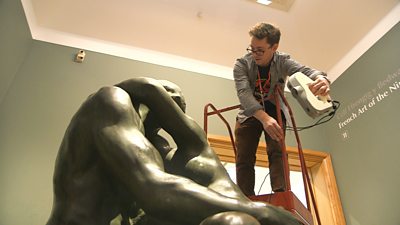As part of our Civilisations Festival digital work over the last year, we’ve been busy beavering away on an Augmented Reality experience to accompany .
Augmented Reality?
, Augmented Reality is a term that describes a lot of things - at the heart of it is the trick of fooling your brain into believing something ‘exists’ in the real world when that illusion is created by a technology. This can be achieved using fire and shadow, or . Most recently it’s come to mean a form of bringing imagery to life through a physical medium that the audience holds or . Up until recently this has been achieved by wearing a device like a Hololens or using a marker of some form and a mobile phone. Over the summer of 2017 there were improvements in hardware and software integration , and , that allowed developers to experiment with marker-less AR using existing mobile platforms like iOS and Android.
We thought this would be a great opportunity to experiment too, and Civilisations seemed like a great fit.
Civilisations
At the heart of is the exploration of the “visual culture of societies from around the globe, revealing alongside the magnificent objects made in the West the wealth of treasures created by other cultures, from the landscape scrolls of classical China and the sculpture of the Olmecs to African bronzes, Japanese prints and Mughal miniatures”. We thought that AR would be a great way to do that allowing us to bring realistic looking objects from our museum partners across the country into the homes and personal spaces of our audience.
The Challenge
The next question was, "How are we going to do this?" In July we put out that led to over 60 submissions - we whittled this down to 3 companies that came in to present us their ideas. The quality and interest across the board was phenomenal but we ultimately decided to work with a London agency, . Their passion for the idea and gave us fuzzy feelings. Work kicked off in earnest in September 2017 on UX & Design as well as some prototyping we’d previously done with another great .
The biggest challenge on this project was coming up with an approach to user experience and design that felt native to Augmented Reality, rather than just a mobile experience that incorporated an element of AR. Nexus (patiently) did multiple rounds of wireframes and presentations for us until we all came to an agreement that what we had felt ‘AR first’. The touchstone for this project was a magic-lens: the idea that our phone screens become a magnifying glass, a torch or a window into another world. That could be magical or realistic but it had to feel natural, even for users that hadn’t had exposure to AR before.
The Content
The second biggest challenge was working with a large array of partners to collate, curate, capture and gather the necessary assets for the experience.
For the magic-lens approach to work we needed more than just photography or video of the art and objects - we needed realistic 3D models. One way to create these are to have an artist model them in a 3D application such as or , but because we wanted realism and authenticity we decided to largely discount this approach. What we were left with was 3D scanning and other forms of acquisition. Although the idea of using a 3D scanner in the heritage and arts industry is reasonably well known, that didn’t mean that everything we wanted to feature in the application had been acquired.
Our fantastic production team collated every response to our engagement and outreach program and, over the course of many meetings and with a structured process, whittled it down to a list of objects that fit the editorial and creative brief best. There were still a few objects and institutions we were really keen to work with but they didn't have the resources or time to scan their objects for us. In the name of gaining and sharing knowledge we organised a Scantiques Roadshow that, over the course of about 2 weeks, would tour the length and breadth of the country scanning our partners objects that had not already been aquired. For this particular project we used an which uses a mix of structured light scanning and image projection to create the kind of quality we’d need for our experience. In a number of cases we also used photogrammetry, a way to create 3D models from a large collection of photos of an object.

We couldn’t have made the app without the contribution of our many museum and gallery partners who provided the fantastic content. We'd also like to give thanks to the third parties who scanned and provided 3D models. This includes The Discovery Programme: Centre for Archaeology and Innovation Ireland for their 3D model of the "Clonmore Shrine", and Liverpool School of Art and Design at Liverpool John Moores University for the scanning and visualisations of the "Horus the Child" statuette and the "Zeus Ammon”.
The future
The Civilisations AR app is going to be launched in the Apple App Store and Google Play in-line with the TV show. We’d love to hear what you think of it, what we could do different or better, and what you’d like to see from us in the future.
- -
-

Future Experience Technologies section
This project is part of the Future Experience Technologies section
